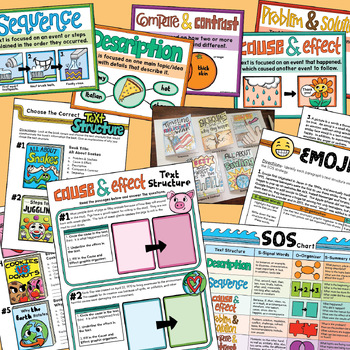Nonfiction Text Structure Activities - Lessons - Ppts - Worksheets - Passages
- Zip
What educators are saying
Description
Identifying text structure in nonfiction passages can be a difficult skill to master. This unit breaks down the skill of determining and finding text structure into 7 lessons that are scaffolded. It includes 7 very detailed lesson plans with 7 interactive PowerPoints that go with each lesson, nonfiction passages, practice printouts, and a final task that assesses each learning target. It is so thorough that the teacher will need little prep time. This unit would also be a great tool to use with intervention groups and tutoring because of the way it is chunked into bite-size lessons. The unit covers the following text structures:
• Description
• Sequence
• Cause/Effect
• Compare/Contrast
• Problem/Solution
Check out our other ELA Units:
Identify and Determine Literary Theme
Purpose of Unit
We created this unit because materials that teach the skill of determining and identifying text structure thoroughly are difficult to find. Most materials rush the process, but identifying text structure takes time and lots of practice. Our goal was to allow the students time to work with the text structures so that they truly would understand the purpose of text structure and how to apply it in their nonfiction reading and writing.
We took the CCSS of RI 4.5 and RI 5.5, and broke it down into digestible lessons. This unit will easily last 3 weeks if not more, but when the students are finished, they will be able to identify and determine text structure throughout their lives. The 7 learning targets in the unit are:
• Understand that writing is a form of communication and that there are different ways to communicate (text structures).
• Define and describe the main characteristics of the text structures: Description, Sequence, Cause and Effect, Compare and Contrast, and Problem and Solution.
• Determine the best text structure to use with a given topic and create book covers for each text structure.
• Determine the best graphic organizer and create a graphic organizer for each text structure.
• Use signal words as a strategy to identifying text structure.
• Identify text structure using signal words, graphic organizers, and summary questions.
• Write a non-fiction text for each text structure.
Unit Includes:
• 7 very detailed, chunked lesson plans with ppts. that include everything a teacher needs.
• Activities for each lesson plan that formatively assesses the learning target.
• Nonfiction text that students will practice the skill of determining and identifying text structure.
• Samples of each lesson
• “I Can” Statements and Essential Questions
• Learning Scales and Student Tracking Sheet based on Marzano’s Learning Scales.
• Summative assessment that asks questions about each learning target.
The unit will work for upper elementary and middle school. This would also be a great tutoring resource for students struggling with text structure because of the way it is chunked into bite-size lessons.
Enjoy!
Hubbard's Cupboard





